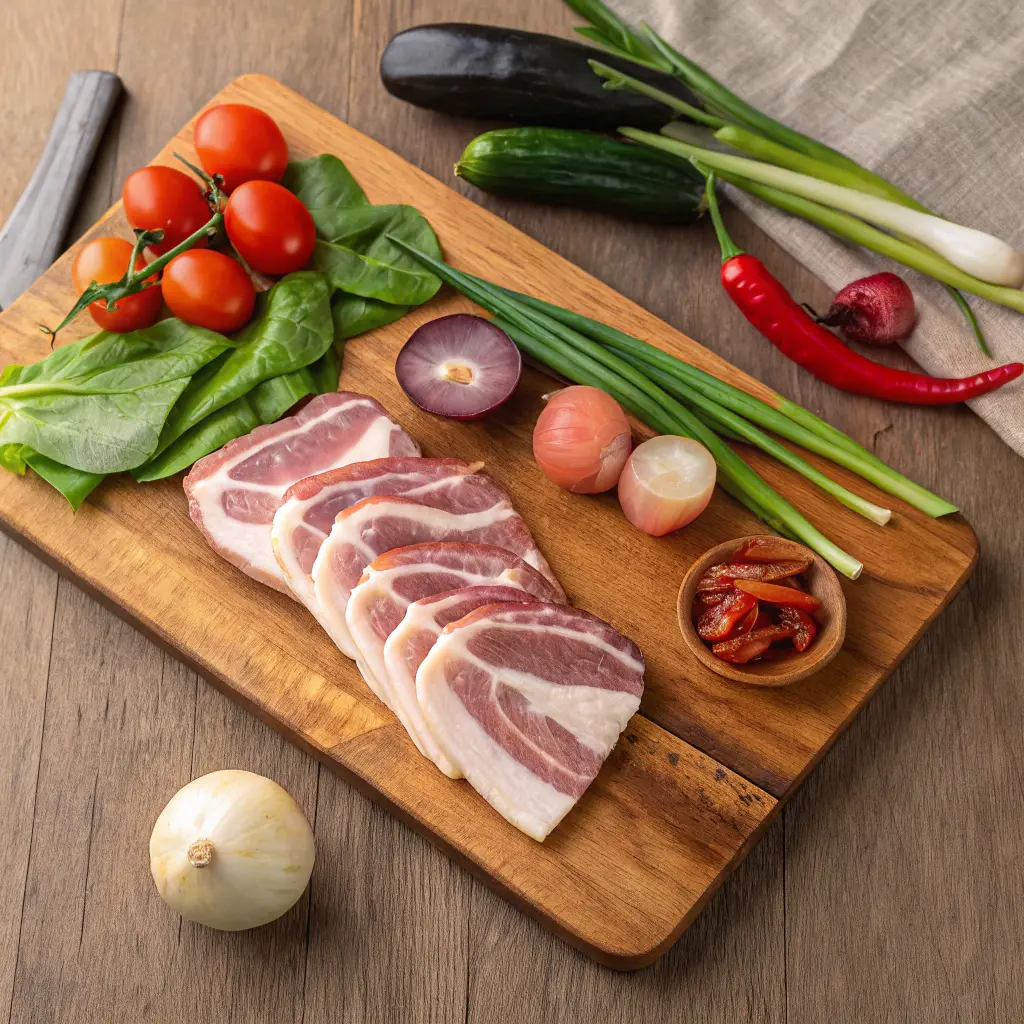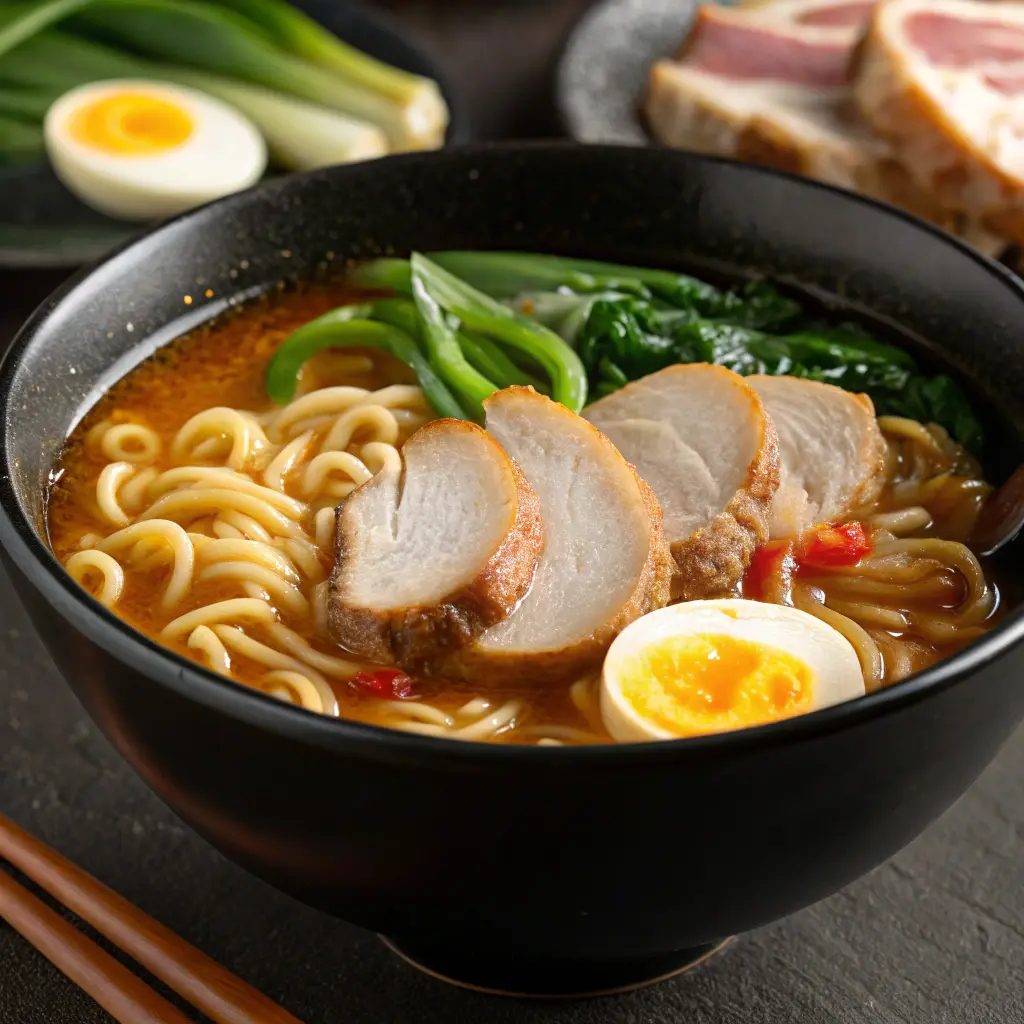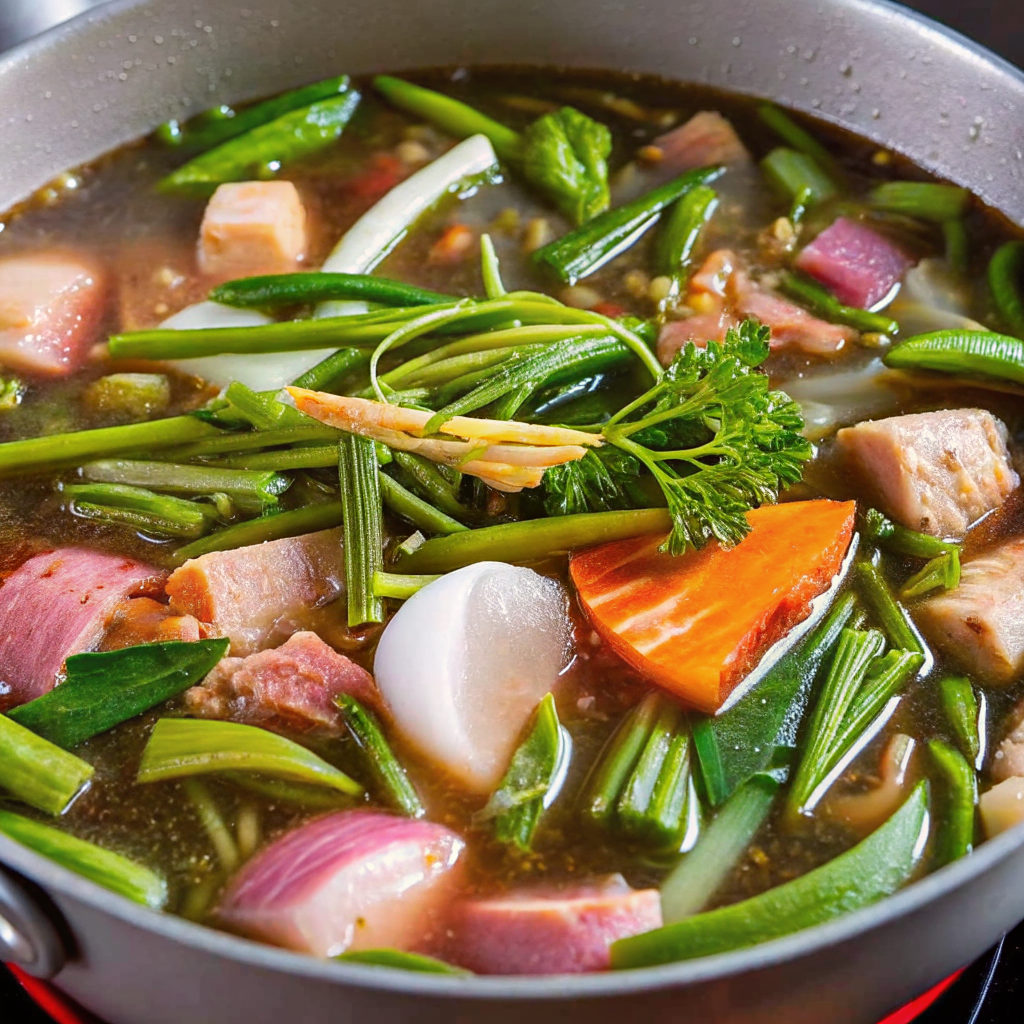If you’re craving a dish that’s rich, sour, and undeniably Filipino, the sinigang recipe is the answer. Sinigang is one of the most iconic comfort foods in the Philippines—loved for its bold tamarind flavor, fresh vegetables, and melt-in-your-mouth pork. Whether it’s a rainy day or a festive occasion, this hearty soup always finds its way to the Filipino dining table. In this guide, we’ll walk you through everything you need to know about sinigang—from its origins and health benefits to variations and a step-by-step cooking method.
Discover great ideas like Natural Mounjaro Recipe – The Best Homemade Drink for Weight Loss and Detox that pair beautifully with warm Filipino soups.
Table of Contents
PART 1: What Is Sinigang?
Understanding the Origins of Sinigang
Sinigang is a Filipino soup or stew known for its sour and savory taste, traditionally derived from tamarind. The word “sinigang” means “stewed” in Tagalog, and the dish dates back to pre-colonial times. While the exact origin is hard to trace, sinigang has long been a staple in Filipino households, often passed down through generations with family-specific twists.
It’s more than just a meal—it’s a cultural symbol that brings people together. Unlike other global soups, sinigang’s signature sourness makes it uniquely appetizing and soothing, especially when served hot over steamed white rice.
Why Sinigang Holds a Special Place in Filipino Cuisine
What makes sinigang truly special is its adaptability. It can be cooked with pork (sinigang na baboy), shrimp (sinigang na hipon), fish (sinigang na isda), or even beef (sinigang na baka). Each variation retains the sour broth essence while taking on the flavor of its primary ingredient.
Sinigang is also widely seen as the ultimate “rainy-day” food. Its steamy, tangy nature warms both the body and soul. And while adobo may be the unofficial national dish, many Filipinos would argue that sinigang represents the heart of Filipino cuisine because of its strong regional ties and homestyle appeal.
The flexibility of the sinigang recipe allows home cooks to adjust ingredients based on what’s available—making it not only comforting but also practical and inclusive. It has even made its mark internationally, with renowned chefs featuring elevated versions on global culinary stages.
PART 2: Ingredients for Sinigang Recipe
Essential Ingredients of Classic Sinigang na Baboy
A traditional sinigang na baboy recipe relies on a carefully chosen blend of meats, vegetables, and souring agents to deliver that comforting, mouthwatering experience. Here’s a breakdown of the staple ingredients:
| Ingredient | Purpose |
|---|---|
| Pork (ribs or belly) | Provides richness and flavor |
| Tamarind (fresh or mix) | Main souring agent, defines the soup’s taste |
| Tomatoes | Adds depth and subtle acidity |
| Onions | Boosts sweetness and aromatics |
| Radish (labanos) | Offers crunch and mild peppery flavor |
| Eggplant | Soaks up the broth, adds texture |
| String beans | Contributes crunch and fiber |
| Water spinach (kangkong) | Traditional leafy green for earthiness |
| Green chili peppers | Adds heat and depth (optional) |
| Fish sauce (patis) | Enhances umami and saltiness |
| Water or pork broth | Soup base for all flavors to blend |

These ingredients form the soul of the dish. For those using sinigang mix, it usually contains powdered tamarind, salt, and artificial flavoring for convenience.
Don’t miss our Beef Plate Ribs: The Ultimate Guide to Flavorful, Fall-Off-The-Bone Perfection, which uses similar slow-simmer techniques perfect for stews.
Common Variations: Seafood, Beef, and Vegetarian Sinigang
The beauty of the sinigang recipe is its versatility. Here are a few popular and delicious twists on the traditional pork-based version:
- Sinigang na Hipon: Made with shrimp, this version cooks faster and has a lighter flavor. Heads-on shrimp infuse extra umami into the broth.
- Sinigang na Baka: Beef short ribs or brisket make this hearty. It requires a longer simmering time for tender meat.
- Sinigang sa Miso: A combination of tamarind and miso paste, this version is rich and tangy—commonly made with bangus (milkfish).
- Vegetarian Sinigang: Skip the meat and double up on the veggies. Add tofu for protein and use mushroom broth for umami depth.
Sourcing fresh, seasonal vegetables makes a huge difference. Ingredients like okra, taro (gabi), and young corn can be included depending on local availability.
Check out Cinnamon Queen Chicken: A Complete Guide to This Prolific Backyard Layer for more protein-rich recipe inspiration.
PART 3: Nutritional Benefits of Sinigang
Is Filipino Sinigang Healthy?
Yes—Filipino sinigang is considered a healthy dish, especially when prepared with lean meats and plenty of vegetables. At its core, sinigang is a broth-based soup, which makes it lighter and lower in calories than fried or creamy Filipino dishes. Here’s why it stands out nutritionally:
- Low in fat (when using lean pork or seafood like shrimp)
- Rich in fiber from vegetables like radish, eggplant, and kangkong
- Natural probiotics in fresh tamarind can aid digestion
- Hydrating due to its high water content
- Anti-inflammatory benefits from vegetables and aromatics like garlic and onions
Additionally, the tamarind base offers antioxidants such as vitamin C and polyphenols, which support immunity and help reduce inflammation. When served with brown rice or quinoa, sinigang becomes a well-balanced, wholesome meal.
The fact that sinigang is simmered and not fried also keeps its fat content in check. You can further lower calories by skimming fat off the broth after boiling.
Looking for inspiration? Try our lesser-known orphan link recipe: Spicy Asian Noodle Soup With Tofu—a nutritious, plant-forward dish also rich in flavor.
What Makes Sinigang a Balanced Meal
A properly made sinigang recipe delivers on all three macronutrients:
- Protein: Pork, beef, shrimp, or tofu
- Carbohydrates: When paired with rice or root vegetables like gabi (taro)
- Healthy fats: Naturally occurring in meat or added in small amounts through fish sauce
It also includes a micronutrient boost from its veggie content—like potassium from kangkong, vitamin A from tomatoes, and iron from leafy greens.
Compared to heavy stews or oily dishes, sinigang is a great option for those managing their weight or blood sugar levels.
Don’t miss our How To Cook Frozen Biscuits In Air Fryer to round out your meal with a convenient side.
PART 4: Step-by-Step Sinigang Baboy Recipe
How to Cook Sinigang Baboy: Traditional Method

Cooking sinigang na baboy from scratch may sound complex, but it’s actually a straightforward process. Here’s a classic step-by-step method for a serving of 4 to 6 people:
Ingredients:
- 1 kg pork belly or ribs (cut into chunks)
- 1 medium onion (quartered)
- 2 medium tomatoes (quartered)
- 1 radish (sliced)
- 1 eggplant (sliced)
- A handful of string beans (cut in half)
- 1 bunch of kangkong (water spinach)
- 2 pcs long green chili peppers
- 1 packet sinigang mix or 1 cup fresh tamarind juice
- 1 tbsp fish sauce (patis)
- Salt and pepper to taste
- 6-8 cups of water
Instructions:
- Boil the meat
In a large pot, combine pork, onion, and tomatoes with 6 cups of water. Bring to a boil and simmer for 45 minutes or until the pork is fork-tender. Skim off any scum that rises. - Add the root vegetables
Toss in radish and continue simmering for 5 minutes. Then, add eggplant and string beans. Cook for another 5 minutes. - Introduce the sour agent
Pour in the sinigang mix or tamarind juice. Stir gently and taste. Adjust sourness by adding more mix or juice to your preference. - Flavor the broth
Season with fish sauce, pepper, and salt. Drop in the green chili for a mild kick. Let it simmer for 2 minutes. - Finish with greens
Add kangkong leaves last to keep them vibrant and slightly crisp. Cook for 1-2 minutes then turn off heat. - Serve hot
Ladle the sinigang into bowls and serve with freshly steamed white rice.
| Pro Tip: For deeper flavor, sauté onions and tomatoes first before boiling. It adds complexity to the broth. |
Don’t miss our Beef Plate Ribs: The Ultimate Guide to Flavorful, Fall-Off-The-Bone Perfection—another dish that thrives on long, slow simmering.
Tips for Enhancing Flavor and Aroma
- Use fresh tamarind pods if possible. Boil them, mash, and strain to extract real tamarind juice.
- Add gabi (taro) for a slightly thick and creamy broth texture.
- Use pork ribs for better flavor compared to lean cuts.
- Roast the tomatoes and onions before boiling for a smokier finish.
- If you’re into fusion, throw in miso paste or even pineapple for a twist.
These simple tweaks can take your sinigang from good to unforgettable.
Check out Cinnamon Queen Chicken: A Complete Guide to This Prolific Backyard Layer for more techniques on building layers of flavor.
PART 5: Different Types of Sinigang You Can Make
Sinigang na Hipon (Shrimp Sinigang)
Sinigang doesn’t always need to be meat-heavy. In coastal regions and health-conscious kitchens, sinigang na hipon is a lighter, quicker alternative. This version uses fresh whole shrimp, including heads, which enrich the broth with seafood umami.
Key ingredients:
- Whole shrimp (shells on)
- Tamarind base or fresh calamansi (for a twist)
- Tomatoes, onions, and common sinigang vegetables like radish and kangkong
Cooking tips:
- Cook shrimp last, as it only takes 2–3 minutes.
- For added aroma, sauté shrimp heads briefly in garlic before boiling.
This version is perfect if you’re short on time but still want something hearty and nourishing.
Sinigang sa Miso and Sinigang sa Bayabas
These two regional variations of the sinigang recipe offer wildly different taste experiences.
Sinigang sa Miso
A specialty from Northern Luzon, this version adds yellow miso paste (fermented soybeans) into the tamarind broth.
- Commonly paired with bangus (milkfish)
- Offers a deeper, savory umami flavor
- Typically sautéed first with garlic and onions
Sinigang sa Bayabas (Guava Sinigang)
This lesser-known version uses ripe guava puree as the souring agent instead of tamarind.
- Has a fruity, slightly sweet flavor
- Often cooked with pork or native chicken
- Great for kids or those who prefer less tangy sinigang
These regional twists prove that sinigang isn’t just one dish—it’s a culinary canvas for creativity.
Other Creative Twists
- Sinigang sa Manggang Hilaw: Uses green mango for sourness
- Sinigang na Baka sa Kamias: Beef simmered in a kamias (bilimbi fruit) base
- Sinigang with Pineapple: Adds tropical sweetness and acidity
These alternatives offer flavor variety without straying from the soul of sinigang: its tangy, warming broth.
Don’t miss our How To Cook Frozen Biscuits In Air Fryer—a smart sidekick to round out your soup meal with ease.
PART 6: Side Dishes and Pairings with Sinigang
What to Serve with Sinigang
Sinigang is already a flavorful, filling main dish—but pairing it with the right sides can take your meal to the next level. Here are classic and creative pairings that go perfectly with sinigang:
1. Steamed White Rice
- The traditional and most essential pairing
- Helps balance the sourness of the broth
- Absorbs the flavorful soup and brings fullness
2. Fried Fish (Daing or Galunggong)
- The crispy, salty texture contrasts beautifully with sinigang’s tangy broth
- Often served with vinegar dipping sauce
3. Tortang Talong (Eggplant Omelet)
- A popular Filipino vegetable dish with eggs and grilled eggplant
- Adds richness and texture to your meal
4. Chicharon (Pork Cracklings)
- Crumbled on top for a savory crunch
- Commonly used in modern restaurant sinigang versions
5. Lumpiang Shanghai (Fried Spring Rolls)
- Provides a satisfying crunch and complements the light, soupy base of sinigang
Looking for inspiration? Try our light and tangy orphan link: Spicy Asian Noodle Soup With Tofu, which also matches well with simple vegetable sides.
Beverage Pairings That Complement the Sour Broth
While sinigang doesn’t usually call for a specific drink pairing, choosing a beverage that matches its acidity and warmth can enhance the overall dining experience.
Best Drink Pairings:
| Drink | Why It Works |
|---|---|
| Calamansi juice | Enhances citrus notes in the broth |
| Salabat (ginger tea) | Balances the tanginess with spice and warmth |
| Cold soda water | Refreshing contrast to the hot and sour soup |
| Coconut water | Sweet and cooling, balances savory flavors |
Check out Natural Mounjaro Recipe – The Best Homemade Drink for Weight Loss and Detox for a drink that doubles as a cleanser and refreshment.
PART 7: Regional and Modern Twists on Sinigang
Regional Versions: Ilocano vs. Tagalog Sinigang
Across the Philippines, the sinigang recipe changes slightly based on geography and local tastes. The Ilocano and Tagalog regions, in particular, have distinctive takes on this beloved dish.

Ilocano Sinigang (Sinigang a Baka)
- Typically uses kamias (bilimbi) or green mango as the souring agent
- Simpler in ingredients, usually just beef and basic vegetables like kangkong and sitaw
- Known for its clean, bold flavors and clear broth
- Sometimes includes bagoong (fermented fish paste) for added saltiness
Tagalog Sinigang (Sinigang na Baboy)
- Commonly uses pork, tamarind, tomatoes, and a wider variety of vegetables
- Richer and slightly heavier broth
- Often incorporates gabi (taro) for extra thickness
These regional variations showcase how sinigang adapts not just to taste but also to what’s locally available, making it a deeply personal and practical dish in many Filipino homes.
Creative Sinigang Fusion Dishes
In recent years, chefs in the Philippines and abroad have been reinventing the traditional sinigang recipe into bold, modern dishes. These fusion spins on sinigang are reshaping how the world sees this classic sour soup.
Popular Modern Twists:
- Sinigang Ramen: Japanese noodles in tamarind broth, topped with chashu pork or crispy tofu
- Sinigang Paella: Rice dish infused with tamarind broth, shellfish, and vegetables
- Sinigang Fried Rice: Leftover broth reduced and mixed into garlicky rice with sinigang meat
- Sinigang Gyoza: Dumplings filled with pork sinigang ingredients, served with tamarind soy dip
These are not just novelty items—they’re a way for new generations to connect with tradition in fun, imaginative ways. While purists may prefer the classic bowl, these dishes prove sinigang’s flavor profile is endlessly adaptable.
Don’t miss our Cinnamon Queen Chicken: A Complete Guide to This Prolific Backyard Layer, a deep dive into a traditional recipe with a modern twist.
PART 8: Frequently Asked Questions About Sinigang (FAQs)
What are the ingredients in sinigang?
The base ingredients of a classic sinigang recipe include:
- Meat or seafood: Pork (baboy), shrimp (hipon), beef (baka), or milkfish (bangus)
- Souring agent: Usually tamarind (fresh or powdered sinigang mix), but may also include green mango, kamias, miso, or guava
- Vegetables: Tomato, onion, radish, string beans, eggplant, water spinach (kangkong), chili peppers
- Seasonings: Fish sauce (patis), salt, pepper, and water or stock
These ingredients work together to create the dish’s trademark balance of sourness, savoriness, and natural sweetness.
Is Filipino sinigang healthy?
Yes, Filipino sinigang is a healthy choice—especially when prepared with lean cuts of meat and plenty of vegetables. Here’s why:
- It’s a broth-based soup, low in fat and calories
- High in fiber, vitamins, and minerals
- Can be easily modified to reduce sodium or fats
- Tamarind provides antioxidants and digestive benefits
When paired with brown rice or quinoa and portioned wisely, sinigang fits well into a balanced diet.
What ingredients of sinigang are mentioned in the selection?
Based on this article, key ingredients in a sinigang recipe mentioned include:
- Pork
- Tamarind
- Onion
- Tomato
- Radish
- Eggplant
- String beans
- Water spinach (kangkong)
- Fish sauce
- Green chili
These items form the essential foundation of the dish and are found in nearly all variations of sinigang.
How to cook sinigang baboy step by step?
Here’s a simplified step-by-step guide to cooking sinigang na baboy:
- Boil pork with onions and tomatoes in water until tender (about 45 minutes)
- Add root vegetables like radish and eggplant; cook 5 minutes
- Stir in sinigang mix or tamarind juice to achieve desired sourness
- Season with fish sauce, salt, pepper, and green chili
- Add greens (kangkong) last, cook 1–2 more minutes
- Serve hot with steamed rice
This method delivers an authentic, homemade taste just like what’s served in Filipino kitchens.
PART 9: Conclusion and Final Thoughts
Why You Should Try Cooking Sinigang at Home
If there’s one dish that captures the soul of Filipino cuisine, it’s sinigang. The sinigang recipe brings together sourness, savory depth, and fresh vegetables in one comforting bowl. Whether you’re new to Filipino food or grew up with it simmering on your family’s stove, sinigang is a recipe worth learning, mastering, and customizing.
It’s not just a meal—it’s an experience. From the boiling pot that fills the kitchen with aroma to the satisfying warmth in every sip, sinigang invites you to slow down and savor. The variety of souring agents, proteins, and veggie combos makes it versatile and ideal for anyone, from meat lovers to plant-based eaters.
Cooking it from scratch lets you control everything: your protein, your level of sourness, even your sodium. You can keep it traditional or go bold with modern twists like miso, green mango, or even fusion dishes like sinigang ramen.
So next time you’re looking for something cozy, nourishing, and full of heart, make sinigang your go-to. It’s healthy, flexible, and absolutely unforgettable.
Looking for inspiration? Try our Natural Mounjaro Recipe – The Best Homemade Drink for Weight Loss and Detox for a refreshing pairing after your hot bowl of sinigang.

